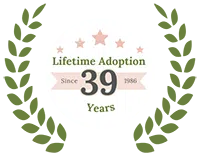Adoption Process For A Child Already Born
At Lifetime Adoption, we frequently get calls from parents or grandparents who are raising children and want to know “How does adoption work for a child already born?” Our caring adoption coordinators can help you and are available 24/7 at 1-800-923-6784 (by TEXT too).
Get Help Now
If you live outside of the U.S., please read. Please use this form to ask us any questions about your situation. All information is confidential. We can help you find answers.
Every call, text, or form you will out with Lifetime is private and confidential. Lifetime adoptions are completely voluntary –this is not foster care or state adoption. We can help you make an adoption for your baby, toddler, or child in a private manner, without the state being involved. (If you already have a case plan with your state worker, you may still be able to adopt. This is called an “intervention” and we may be able to help with that too!)
Some women wonder, “Are there families to adopt all of my children?” The answer is yes. Lifetime has assisted in many adoptions of groups of two or more siblings at one time. We believe strongly in keeping siblings together.
Here are the steps to planning an adoption for a child you are raising:
1. Reach out to an Adoption Agency
Call, text, or fill out our short contact form. You can speak to a caring adoption coordinator that can help answer your questions about the adoption process for a child already born. Depending on your specific needs and situation, she can help you with the best approach. Every adoption is different.
One of the things your coordinator will do is gather information about your child. She will ask basic questions about both of you, including your child’s development and health. Depending on your child’s age, she may also ask about interests, favorite toys, progress in school, and general behavior. There are adoptive families open to adopting every child, and by gathering as much information from you, she will be able to help you in the best way possible.
You will also be asked to gather a few things if possible. If you don’t have them, we can help request them, but for the adoption to proceed quickly, providing copies (or texting images) is the best way. You will be asked for copies or pictures of your child’s:
- Birth certificate
- Social security card
- School records, if applicable (or your coordinator can request them on your behalf)
- Medical records (or your coordinator can request them on your behalf)
You don’t have to have these right now, but it is good to know so you can start gathering the things you need.
2. Complete Your Paperwork
Your coordinator will prepare some paperwork for you to complete, or you may complete the adoption paperwork online. It is informational in nature and is not the final legal paperwork. It includes health history and medical releases.
You will also need to send copies of the documents listed in the first step above, as well as a copy of your ID.
Using this information, your coordinator will be able to compile information on waiting adoptive parents for you to consider for adopting your child or children. She will mail or email information about them, which may include a letter, photos, videos, and a full-length profile about them.
During this time, we will also schedule a time that you can speak with a counselor who can talk to you about your decision-making process and help as you prepare to transition your child to his or her new family. There is no charge for this and it is a vital part of the adoption planning process.
3. Choose Adoptive Parents for Your Child
Start by using our search families tool. You can search our nationwide list of families who are screened and ready to adopt. And even better, you can search by the things that are most important to you.
After that, you may decide you’d like to speak with one or more families. This will help you make your adoption decision and also give you the opportunity to talk about what type of contact you would like in the future. All of the adoptive families that Lifetime works with are open to keeping in touch with you, through letters, photos, email, texting, phone calls, social media, and even getting together once or twice a year for a visit.
You may have some questions for them about their life and interests, and they may have some for you about you and your child. If you prefer, your coordinator can be a part of the phone call or you can start by emailing them. You can even speak with more than one family if you’d like.
Our adopting couples come from all over the U.S., even Alaska and Hawaii, and you’ll find that each family is unique. There are families of different races, interests, lifestyles, levels of education and professions.
Sometimes women ask “How do I decide on the family for my child or children?”, and the answer starts with just looking at them. If you have certain characteristics in mind, your coordinator can show you waiting families with those qualities. As you start to look at families, you will begin to get a picture of what want.
Another question we hear is “How can you be sure the adoptive parents are safe?”
All Lifetime families have a completed ‘home study’ report. This contains background checks, medical and financial histories, a home inspection, personal interviews, and much more. Lifetime adoptive families are also ready to commit to an open adoption. They are ready to get to know your child and you, as well as the dreams you have for your child.
4. Meet the Parents and Begin a Transition Plan
Once you choose an adoptive family, they will travel to your town to spend time with you and your child or children. When you all decide you wish to move forward with an adoption, you are considered ‘matched’. Your Lifetime coordinator is still walking with you every step of the way.
An attorney and counselor may be involved soon to create a transition plan for your child. For a very young baby, this may be a short period of time. For an older child, it may last over a week or two, with guidance from a counselor. Understand that it is highly recommended that the transition time not exceed two weeks. Every situation is different and your coordinator will be sure that your needs are being met too.
During this transition time, you may meet with the attorney to learn about your rights and begin to complete the paperwork for the legal aspect of adoption. You may also want to schedule time to speak with the counselor or a peer counselor.
You may want to write a letter to your child and gather some of his or her favorite things, like blankets or stuffed animals. After you have signed the final adoption paperwork, your child and chosen family will go to their home. You will have the time you need to say goodbye, knowing that this is not goodbye forever, but that you will stay in touch.
5. Life After Adoption for You and Your Child
After the adoption is completed, you will continue receiving updates and staying in contact with the adoptive parents as you have requested. There may be a time at the beginning when you need more contact or you may need to take a break. Be honest with the family and your Lifetime coordinator. Your coordinator is always there for you and can help facilitate any help you need. She can help with future planning if you need it, including referrals to support and scholarship programs. The counselors and peer support staff is also still available to you.
Your child will begin to adjust to his new home, family, and surroundings. You will remain a part of his or her life as you have requested. You may have friends or family question your decision, but it is not something to be embarrassed by. You’ve provided for your child in a selfless way, trying to provide for them what they need for a safe and secure future.
One important thing to remember is that the relationship you are creating with the family you’ve chosen for your child or children is for a lifetime.
Learn About the Process for Other Situations

Lifetime Adoption, Inc. is a Licensed Child Placing Agency in Arkansas. (License AR #00050809)
Copyright © | Lifetime Adoption










